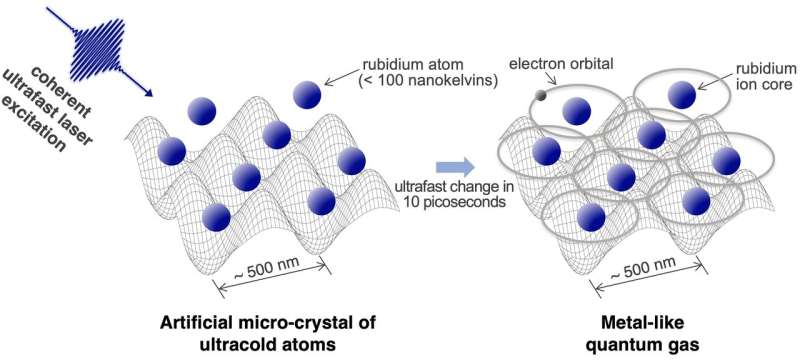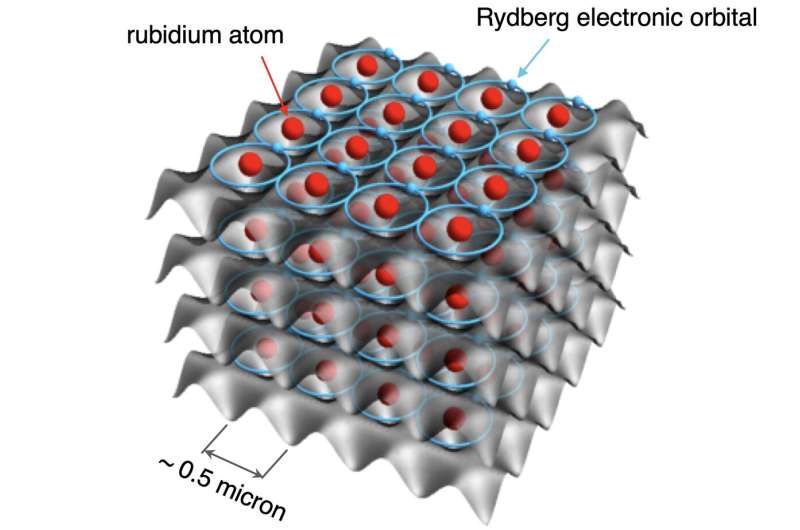Fig. 1. Schematic of the metal-like quantum gas. Credit: NINS/IMS
Electronic properties of condensed matter are often determined by an intricate competition between kinetic energy that aims to overlap and delocalize electronic wave functions across the crystal lattice, and localizing electron-electron interactions. In contrast, the gaseous phase is characterized by valence electrons tightly localized around the ionic atom cores in discrete quantum states with well-defined energies. As an exotic hybrid of both situations, one may wonder which state of matter is created when a gas of isolated atoms is suddenly excited to a state where electronic wave functions spatially overlap, like in a solid?
Such an exotic phase of matter, however, has so far been impossible to create in principle. Here, Professor Kenji Ohmori, Institute for Molecular Science, National Institutes of Natural Sciences in Japan, and his coworkers have realized such an exotic hybrid with overlapping high-lying electronic (Rydberg) wave functions created coherently within only 10 picoseconds by ultrafast laser excitation in an artificial micro-crystal of ultracold atoms. The degree of spatial overlap is actively tuned with nearly 50 nanometer precision and accuracy. This exotic metal-like quantum gas under exquisite control and long-lived, decaying in nanoseconds, opens up a completely new regime of many-body physics for simulating ultrafast many-body electron dynamics dominated by Coulomb interactions.
The experiment was performed with an ensemble of 30,000 rubidium atoms in the gas phase. It was cooled to a temperature below one 10 millionth of 1 Kelvin above an absolute zero temperature by laser/evaporative cooling. Those ultracold atoms in the energetically lowest quantum state, referred to as a Bose-Einstein condensate, are loaded into a cubic lattice of optical traps formed with counter-propagating laser beams, resulting in an artificial micro-crystal consisting of 30,000 atoms, whose nearest neighbor distance is 0.5 micron. This micro-crystal with a size of a few tens of micrometers was irradiated with an ultrashort laser pulse whose pulse width was 10 pico-seconds. It was then observed that an electron confined in each of the neighboring atoms was excited to its giant electronic orbital (Rydberg orbital), so that they spatially overlapped with each other. The degree of the overlap was exquisitely controlled with nearly 50 nanometer precision and accuracy by changing the laser frequency which selects the orbital.
Schematic of a new quantum simulator assembled with the metal-like quantum gas for simulating many-body electrons dominated by Coulomb interactions. Credit: NINS/IMS
When the orbitals of these loosely bound electrons overlap each other and the atoms start to share their orbitals, they enter into a new metal-like quantum-gas regime. Prof. Ohmori and his coworkers have thus created a metal-like quantum gas for the first time. This exotic matter phase is expected as a pathbreaking platform for quantum simulation of ultrafast many-body electron dynamics dominated by Coulomb interactions that would enhance our understanding of physical properties of matter including superconductivity and magnetism, and could contribute to disruptive innovation in the development of new functional materials.
The study is published in Physical Review Letters.
Video version of Fig. 2. Schematic of a new quantum simulator assembled with the metal-like quantum gas for simulating many-body electrons dominated by Coulomb interactions. Credit: NINS/IMS and Hamamatsu Photonics K.K.
More information: Ultrafast creation of overlapping Rydberg electrons in an atomic BEC and Mott-insulator lattice. Physical Review Letters, DOI: 10.1103/PhysRevLett.124.253201
Journal information: Physical Review Letters
Provided by National Institutes of Natural Sciences

























